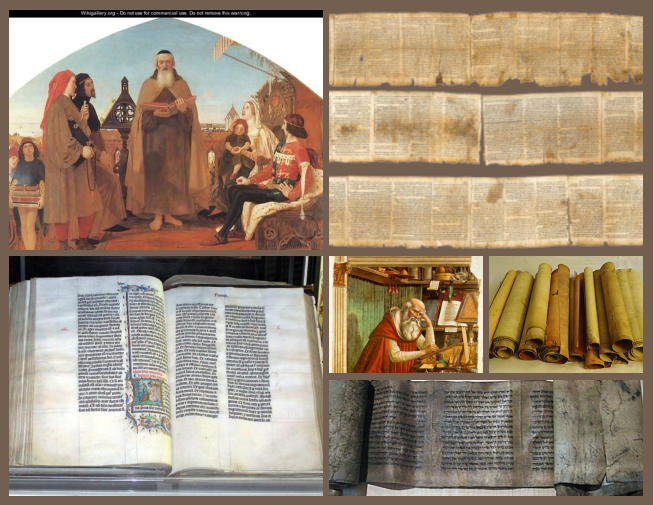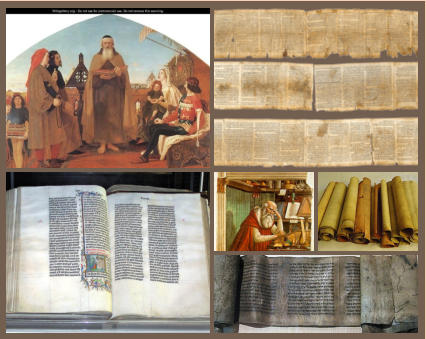

top,
left
to
right
-
"The
First
Translation
of
the
Bible
into
English:
Wycliffe
Reading
His
Translation
of
the
Bible
to
John
of
Gaunt";
“The Great Isaiah Scroll” - housed in the Shrine of the Book in the Israel Museum
middle,
left
to
right
-
“
Saint
Jerome
in
His
Study,”
fresco
by
Domenico
Ghirlandaio
located
in
the
church
of
Ognissanti,
Florence;
100-600-year-old scrolls from a private collection
bottom, left to right - A Bible handwritten in Latin, on display in Malmesbury Abbey, Wiltshire, England; “The Book of Esther,” from
the 13th or 14th Century, on display at the Musée du quai Branly, Paris, France
---all attributions at page bottom---
• Ford Madox Brown – Creative Commons license, via Wikipedia Commons
• Ardon Bar Hama, author of original document is unknown, Public domain, via Wikipedia Commons
• Creative Commons Attribution-Share Alike License 3.0, via Wikipedia Commons
• Mike Izbicki, 2014-08-10- scribal traditions of "ancient" Hebrew scrolls, Creative Commons attribution-share alike
• Adrian Pingstone. Public domain, via Wikipedia Commons
• Deror avi, 2009-02-13, Public domain, via Wikipedia Commons
“And
I
saw
the
dead,
the
great
and
the
small,
standing
before
the
throne,
and
books
were
opened;
and
another
book
was
opened,
which
is
the
book
of
life;
and
the
dead
were
judged
from the things which were written in the books, according to their deeds” (Revelation 20:12).
Codex: the Bible Becomes the Bible
The
use
of
“book”
in
the
Bible
is
an
anachronism,
since
books,
as
they
are
known
today,
did
not
then
exist.
Instead,
ancient
“books”
were
“scrolls,”
or
rolls
of
papyrus,
which
were
opened
by
being
unwound.
When
Jesus
“closed
the
book”
of
Isaiah
in
the
Nazareth
synagogue,
He
“rolled”
it
up
(Lk.
4:20).
John
said
the
sky
was
“split
apart
like
a
scroll
when
it
is
rolled
up”
(Rev.
6:14),
and
the
Psalmist
refers
to
“the
roll
of
the
book”
(cf.
Psa.
40:7;
Heb.
10:7,
NASB).
Thus,
to
translate
the
Greek
words,
“biblion”
or
“biblos”
(whence,
“Bible”),
as
“book”
is
an
accommodation
to
modern
conceptions.
Moving
to
different
parts
of
a
scroll
was
cumbersome.
Bible
readers
are
now
accustomed
to
being
able
to
move
quickly
from
one
text
to
another,
but
this
was
not
easily
done
by
scroll
users.
In
fact,
the
larger
books
of
the
Bible
by
themselves
might
occupy
all
the
space
of
a
single
scroll.
For
example,
when
Jesus
was
given
the
scroll
of
Isaiah
(Lk.
4:17),
He
presumably
had
to
unroll
it
almost to its end to find the place from which He read (Isa. 61:1ff).
Adding
the
twenty-seven
New
Testament
books
increased
the
size
of
the
Bible
and
the
occasion
to
move
rapidly
among
Biblical
texts
for
cross-referencing.
So,
having
sixty-six
books
on
scrolls became inconvenient, if not untenable, for the kind of Bible study which was needed.
This
situation
led
to
the
development
of
the
codex,
which
was
essentially
the
modern
book.
Codices
allowed
texts
to
be
written
on
the
fronts
and
backs
of
leaves,
or
pages,
which
were
piled
atop
one
another
in
textual
order
and
bound
together
by
stitching
on
one
edge
to
produce
a
book.
The
codex
had
the
great
advantage
of
giving
readers
access
to
a
large
amount
of
text
in
a
much
more
compact
and
usable
form,
and
especially
of
allowing
them
to
move
easily
from
one
text
to
another.
In
fact,
Christians
are
credited
with
having
developed,
or
popularized,
the
codex.
The
oldest
codices
are
Bibles.
Indeed,
the
codex
was
such
an
improvement
that
it
caused
the
extinction
of
the
scroll
as
a
literary
vehicle
within
a
few
centuries.
Because
of
the
interest
early
Christians
had
in
expediting
Bible
reading
and
study,
it
is
hardly
an
exaggeration
to
say
that
they
were
responsible
for
giving
the
world the book.
What
is
more
important
is
how
the
codex
might
have
affected
how
the
Bible
was
viewed,
studied,
and
interpreted.
With
the
codex,
the
Bible’s
sixty-six
books
had,
for
the
first
time,
physically
become
one
Book,
so
that
John
Chrysostom,
in
the
fourth
century,
first
called
it
“the
Bible.”
Now,
Christians,
in
a
very
practical
sense,
could
see
the
Bible
as
one
book.
This
held
significant
implications.
It
raised
the
question
of
“canonicity,”
or
which
books
were
God’s
word
and,
therefore,
deserved
a
place
within
its
covers.
This,
in
turn,
led
to
an
appreciation
of
the
fact
that
a
book’s
contents
had
to
agree
with
the
other
books
in
the
Bible.
This
implied
that
the
Bible
was
to
be
treated
and
interpreted
holistically,
so
that
what
one
book
said
had
to
be
interpreted
in
the
light
of
what
every
other
book
in
the
Bible
said.
Because
the
Biblical
books
were
really
one
book,
this
meant
that
the
teaching
of
God’s
word
had
to
be
deduced
through
a
process
of
consulting
and
integrating
into
a
harmonious
whole
all
of
its
relevant
texts.
The
Bible
in
the
form
of
a
codex
made
it
practical
to
do
this.
It
allowed
a
Bible
student
to
do
in
seconds
what
took
the
scroll
user
minutes.
This
encouraged
the
comparison
and
integration
of
related
parts
of
the
Bible
and,
in
turn,
the
recognition,
confirmation, and presentation of Bible doctrine.
From
this
perspective,
then,
putting
the
books
of
the
Bible
together
in
a
codex
was
when
they
came
together as the Bible, and now as then, it must be treated and interpreted as one Book.
Copyright © 2017 - current year, Gary P. and Leslie G. Eubanks. All Rights Reserved.


top,
left
to
right
-
"The
First
Translation
of
the
Bible
into
English:
Wycliffe
Reading
His
Translation
of
the
Bible
to
John
of
Gaunt";
“The
Great
Isaiah
Scroll”
-
housed
in
the Shrine of the Book in the Israel Museum
middle,
left
to
right
-
“
Saint
Jerome
in
His
Study,”
fresco
by
Domenico
Ghirlandaio
located
in
the
church
of
Ognissanti,
Florence;
100-600-year-old
scrolls
from
a
private collection
bottom, left to right - A Bible handwritten in Latin, on display in Malmesbury Abbey,
Wiltshire, England; “The Book of Esther,” from the 13th or 14th Century, on display
at the Musée du quai, Paris, France
---All attributions at page bottom---
• Ford Madox Brown – Creative Commons license, via Wikipedia Commons
• Ardon Bar Hama, author of original document is unknown, Public domain, via Wikimedia
Commons
• Creative Commons Attribution-Share Alike License 3.0, viWikipedia Commons
• Mike Izbicki, 2014-08-10- scribal traditions of "ancient" Hebrew scrolls, Creative
Commons attribution-share alike
• Adrian Pingstone. Public domain Wikimedia Commons
• Deror avi, 2009-02-13, Public domain, via Wikimedia Commons
“And
I
saw
the
dead,
the
great
and
the
small,
standing
before
the
throne,
and
books
were
opened;
and
another
book
was
opened,
which
is
the
book
of
life;
and
the
dead
were
judged
from
the
things
which
were
written
in
the
books,
according
to
their
deeds”
(Revelation 20:12).
Codex: the Bible Becomes the Bible
The
use
of
“book”
in
the
Bible
is
an
anachronism,
since
books,
as
they
are
known
today,
did
not
then
exist.
Instead,
ancient
“books”
were
“scrolls,”
or
rolls
of
papyrus,
which
were
opened
by
being
unwound.
When
Jesus
“closed
the
book”
of
Isaiah
in
the
Nazareth
synagogue,
He
“rolled”
it
up
(Lk.
4:20).
John
said
the
sky
was
“split
apart
like
a
scroll
when
it
is
rolled
up”
(Rev.
6:14),
and
the
Psalmist
refers
to
“the
roll
of
the
book”
(cf.
Psa.
40:7;
Heb.
10:7,
NASB).
Thus,
to
translate
the
Greek
words,
“biblion”
or
“biblos”
(whence,
“Bible”),
as
“book”
is
an
accommodation to modern conceptions.
Moving
to
different
parts
of
a
scroll
was
cumbersome.
Bible
readers
are
now
accustomed
to
being
able
to
move
quickly
from
one
text
to
another,
but
this
was
not
easily
done
by
scroll
users.
In
fact,
the
larger
books
of
the
Bible
by
themselves
might
occupy
all
the
space
of
a
single
scroll.
For
example,
when
Jesus
was
given
the
scroll
of
Isaiah
(Lk.
4:17),
He
presumably
had
to
unroll
it
almost
to
its
end
to
find
the
place
from
which
He
read
(Isa.
61:1ff).
Adding
the
twenty-seven
New
Testament
books
increased
the
size
of
the
Bible
and
the
occasion
to
move
rapidly
among
Biblical
texts
for
cross-referencing.
So,
having
sixty-six
books
on
scrolls
became
inconvenient,
if
not
untenable,
for
the
kind
of
Bible
study which was needed.
This
situation
led
to
the
development
of
the
codex,
which
was
essentially
the
modern
book.
Codices
allowed
texts
to
be
written
on
the
fronts
and
backs
of
leaves,
or
pages,
which
were
piled
atop
one
another
in
textual
order
and
bound
together
by
stitching
on
one
edge
to
produce
a
book.
The
codex
had
the
great
advantage
of
giving
readers
access
to
a
large
amount
of
text
in
a
much
more
compact
and
usable
form,
and
especially
of
allowing
them
to
move
easily
from
one
text
to
another.
In
fact,
Christians
are
credited
with
having
developed,
or
popularized,
the
codex.
The
oldest
codices
are
Bibles.
Indeed,
the
codex
was
such
an
improvement
that
it
caused
the
extinction
of
the
scroll
as
a
literary
vehicle
within
a
few
centuries.
Because
of
the
interest
early
Christians
had
in
expediting
Bible
reading
and
study,
it
is
hardly
an
exaggeration
to
say that they were responsible for giving the world the book.
What
is
more
important
is
how
the
codex
might
have
affected
how
the
Bible
was
viewed,
studied,
and
interpreted.
With
the
codex,
the
Bible’s
sixty-six
books
had,
for
the
first
time,
physically
become
one
Book,
so
that
John
Chrysostom,
in
the
fourth
century,
first
called
it
“the
Bible.”
Now,
Christians,
in
a
very
practical
sense,
could
see
the
Bible
as
one
book.
This
held
significant
implications.
It
raised
the
question
of
“canonicity,”
or
which
books
were
God’s
word
and,
therefore,
deserved
a
place
within
its
covers.
This,
in
turn,
led
to
an
appreciation
of
the
fact
that
a
book’s
contents
had
to
agree
with
the
other
books
in
the
Bible.
This
implied
that
the
Bible
was
to
be
treated
and
interpreted
holistically,
so
that
what
one
book
said
had
to
be
interpreted
in
the
light
of
what
every
other
book
in
the
Bible
said.
Because
the
Biblical
books
were
really
one
book,
this
meant
that
the
teaching
of
God’s
word
had
to
be
deduced
through
a
process
of
consulting
and
integrating
into
a
harmonious
whole
all
of
its
relevant
texts.
The
Bible
in
the
form
of
a
codex
made
it
practical
to
do
this.
It
allowed
a
Bible
student
to
do
in
seconds
what
took
the
scroll
user
minutes.
This
encouraged
the
comparison
and
integration
of
related
parts
of
the
Bible
and,
in
turn,
the
recognition,
confirmation,
and
presentation
of
Bible
doctrine.
From
this
perspective,
then,
putting
the
books
of
the
Bible
together
in
a
codex
was
when
they
came
together
as
the
Bible,
and now as then, it must be treated and interpreted as one Book.











